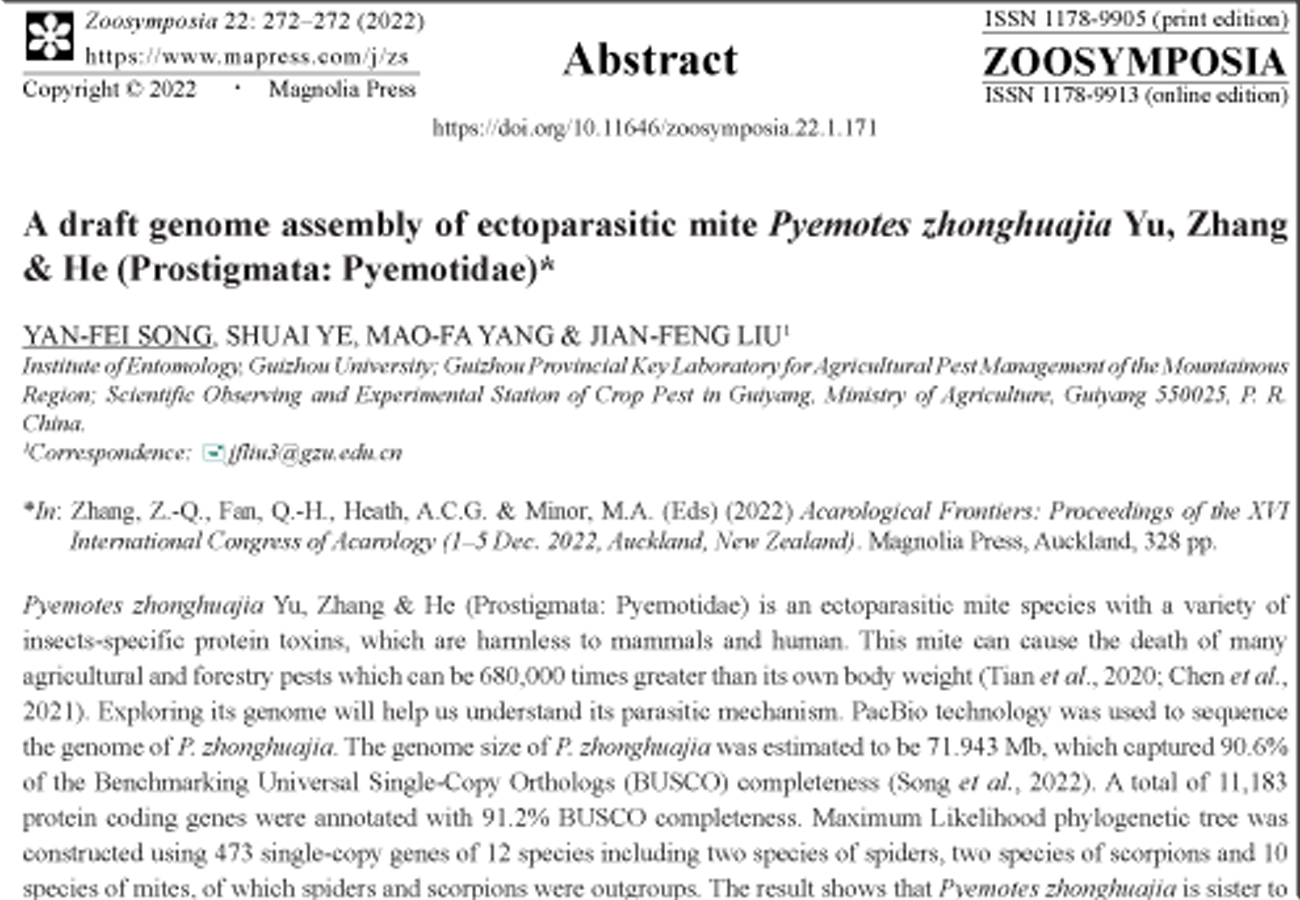Abstract
Pyemotes zhonghuajia Yu, Zhang & He (Prostigmata: Pyemotidae) is an ectoparasitic mite species with a variety of insects-specific protein toxins, which are harmless to mammals and human. This mite can cause the death of many agricultural and forestry pests which can be 680,000 times greater than its own body weight (Tian et al., 2020; Chen et al., 2021). Exploring its genome will help us understand its parasitic mechanism. PacBio technology was used to sequence the genome of P. zhonghuajia. The genome size of P. zhonghuajia was estimated to be 71.943 Mb, which captured 90.6% of the Benchmarking Universal Single-Copy Orthologs (BUSCO) completeness (Song et al., 2022). A total of 11,183 protein coding genes were annotated with 91.2% BUSCO completeness. Maximum Likelihood phylogenetic tree was constructed using 473 single-copy genes of 12 species including two species of spiders, two species of scorpions and 10 species of mites, of which spiders and scorpions were outgroups. The result shows that Pyemotes zhonghuajia is sister to Tetranychus urticae. An estimate of species divergence time showed that P. zhonghuajia and T. urticae emerged during Triassic (223.43~247.66 Mya). In P. zhonghuajia, there were 621 gene families (containing 1,224 genes) expanded, and 3664 gene families (containing 3,927 genes) contracted. Most importantly, we found that P. zhonghuajia contained three types of toxin proteins, which were neurotoxins, dermonecrotic toxins and agatoxins. Neurotoxin and dermonecrotic toxin-related genes are significantly expanded. The toxin-related gene expression level of one-day-old mites was higher than that of seven-day-pregnant mites, which might explain why one one-day-old mite had such strongly toxin (Chen et al., 2021). We also verified the function of the toxin proteins and explored its effect on insect cells to lay a theoretical foundation for the study and development of biopesticides with multi-target insecticidal toxins (Song et al., 2022).
References
Chen, Y.-C., Tian, T.-A., Chen, Y.-H., Yu, L.-C., Hu, J.-F., Yu, X.-F., Liu, J.-F. & Yang, M.-F. (2021) The biocontrol agent Pyemotes zhonghuajia has the highest lethal weight ratio compared with its prey and the most dramatic body weight change during pregnancy. Insects, 2021, 12, 490. https://doi.org/10.3390/ insects12060490
Tian, T.-A.,Yu, L.-C., Sun, G.-J., Yu, X.-F., Li, L.-T., Wu, C.-X., Chen, Y.-C., Yang, M.-F. & Liu, J.-F. (2020a) Biological control efficiency of an ectoparasitic mite Pyemotes zhonghuajia on oriental armyworm Mythimna separata. Systematic and Applied Acarology, 25(9), 1683–1692. https://doi.org/10.11158/saa.25.9.13
Tian, T.-A.,Yu, L.-C., Yu, X.-F., Li, L.-T., Sun, G.-J., Zhang, H.-Y., Liu, J.-F. & Yang, M.-F. (2020b) Proper hunger increased the lethal efficiency of the ectoparasitic mite Pyemotes zhonghuajia (Trombidiformes: Pyemotidae). Systematic and Applied Acarology, 25(9), 1661–1667. https://doi.org/10.11158/saa.25.9.11
Song, Y.-F., Yu, L.-C., Yang, M.-F., Ye, S., Yan, B., Li, L.-T., Wu, C. & Liu., J.-F. (2022) A long-read genome assembly of a native mite in China Pyemotes zhonghuajia Yu, Zhang & He (Prostigmata: Pyemotidae) reveals gene expansion in toxin-related gene families. Toxins, 14, 571. https://doi.org/10.3390/toxins14080571

